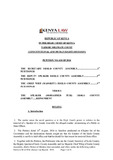On-farm Musa germplasm diversity in different agro ecologies of Burun

View/
Date
2013-12Author
Ocimati, W
Blomme, G
Karamura, D
Ragama, P
Lepoint, P
Ragama, p
Kanyaruguru, J. P
Ngezahayo, F
Ndungo, V
.Hakizimana, S
Metadata
Show full item recordAbstract
urundi is part of the secondary centre of diversity for the east African highland bananas (Musa AAA EA). However, Musa diversity in Burundi has declined in the past two decades due to pests, diseases
and civil unrest. A Musa germplasm diagnostic survey carried out in three provinces- Gitega in Central,
Kirundo in Northern and Cibitoke in north-western Burundi, assessed on-farm Musa diversity, Musa
selection criteria influencing Musa diversity and genetic erosion. Musa diversity was determined by the
number and relative abundance of Musa cultivars in the study communities. Thirty-three (33) cultivars
were recorded across the three provinces. Gitega and Kirundo had a higher Musa diversity than
Cibitoke. Low Musa diversity in Cibitoke can be attributed to the existence of a few cultivars adapted to
the low altitude; specialization in beer types for the market and the effect of diseases. Though 11
cultivars were widely grown, only four covered 77% of the Burundian banana landscape. These
cultivars have a high market potential. The less common cultivars are vulnerable to genetic erosion and
hence their conservation is recommended. Flavour, pulp taste and juice quality; and market
demand/prices greatly influenced cultivars maintained on farm. 30% of the respondents experienced
cultivar erosion, with 69% reporting loss in Cibitoke, 29% in Kirundo and 19% in Gitega. Diseases (89%)
were the major cause of this loss. ‘Kamaramasenge’ (AAB), ‘Igisubi’ (ABB) and ‘Pisang awak’ (ABB),
respectively were the most affected cultivars. Banana bunchy top disease indiscriminately affects Musa
cultivars in the low altitude regions, while the AAB dessert types and the ABB beer types are affected
by Fusarium wilt. The high disease burden at low altitudes could partially be responsible for the low
Musa diversity in Cibitoke
Collections
- Publications 2019 [91]
